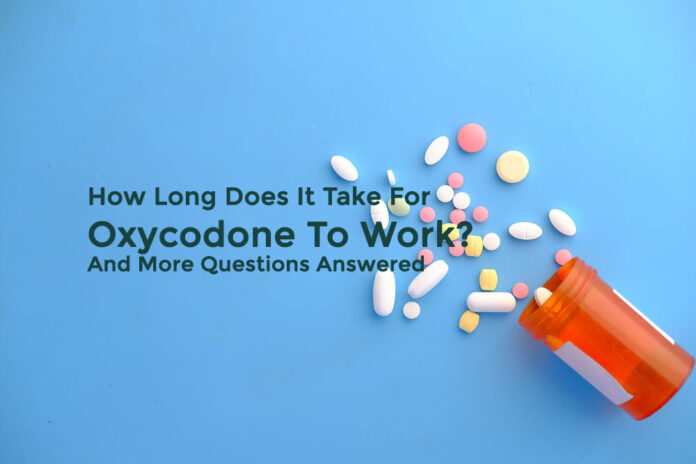Oxycodone is an opioid medication often prescribed to individuals managing pain. While it can be effective, it’s important to be aware of all aspects of this drug before starting a regime.
One common question people have with oxycodone is: How long does it take for oxycodone to work?
This post will dive into the details of how oxycodone works in your body, how long it lasts, who it is prescribed to, and answer those wondering, “how long does it take for oxycodone to work?”
What is oxycodone?
Oxycodone is a powerful opioid pain medication used to treat chronic, severe pain in patients resistant to other types of analgesic treatments. The medication works by targeting the brain and nervous system to block pain signals from reaching the brain, thereby reducing pain sensation. Oxycodone is available in both short-acting and long-acting formulations, and is often used alongside other pain medications to provide long-lasting pain relief.
How long does it take for oxycodone to work?
The amount of time for oxycodone to start working differs based on various factors including the dosage and form (immediate release vs. controlled release). When taking immediate release oral oxycodone, the body processes it quickly, so its effects can usually be experienced within 30 minutes of taking the medication.
After around 30-60 minutes, peak effects of the medication are experienced. Since everyone’s body is different, the onset of action may differ for each person. Patients should always consult their doctor regarding the proper dosage and timing for their oxycodone prescription.
Who can be prescribed oxycodone?
Oxycodone is primarily prescribed to patients who are suffering from chronic, severe pain due to medical conditions such as cancer, degenerative arthritis, or terminal illness. Doctors carefully evaluate these patients’ medical histories and condition before prescribing oxycodone, as well as closely monitor the patient’s usage to avoid any potential addiction or overdose.
What makes oxycodone addictive?
The reason why oxycodone is addictive is that it interacts with the reward center of the brain. This area is in charge of pleasure and reward sensations, and oxycodone affects it by releasing dopamine, which induces pleasurable feelings. Over time, patients who take oxycodone may develop a tolerance to the drug’s effects on dopamine, leading them to need higher doses to feel the same relief.
This pattern can ultimately lead to addiction, which is why healthcare providers are cautious about prescribing oxycodone due to its addictive nature. They carefully evaluate its advantages and disadvantages before administering oxycodone to patients, given the growing awareness of its addictive properties.
Wrap-Up: Use This Guide Before Using Oxycodone
One reason why the question “how long does it take for oxycodone to work?” is so common is due to the intensity of the drug. Oxycodone is a powerful pain medication that should always be taken as prescribed by a healthcare practitioner. It takes up to 30 minutes for the medication to start working, and its effects can last from four to six hours. Since oxycodone is a drug with such a high risk for abuse, it is typically only prescribed for those who suffer from chronic and severe pain.
While oxycodone does provide powerful pain relief, it also can be highly habit-forming which needs to be kept in mind when using it. Taking the recommended dosage of this drug is critical to prevent adverse effects and potential abuse.
Read Also
- The Future of Men’s Health: Why Telehealth Is Here to StayTelehealth isn’t just a pandemic trend that faded into the background. For Australian men, it has become one of the most practical, time-saving, and stress-free ways to manage everyday health — and it’s shaping the future of how we access care. Platforms like DOCTO, an Australian online doctor and specialist telehealth service, are leading the… Read more: The Future of Men’s Health: Why Telehealth Is Here to Stay
- How to Build a Simple, Clean Skincare Routine ?You don’t need a complicated skincare routine. It doesn’t have to be something that requires twenty different products and confusing steps. Your routine works well with just a few high-quality clean ingredients. The beauty industry keeps pushing more products, but your skin actually needs less. You only need a simple approach to get better results… Read more: How to Build a Simple, Clean Skincare Routine ?
- How Preventive Dental Care Supports Overall HealthHave you ever wondered how a simple dental checkup could impact your entire body? Oral health is more than just a bright smile. Studies show that poor dental habits can contribute to serious health problems. Gum disease and tooth decay are linked to heart disease, diabetes, and infections. Yet, many people overlook preventive dental care.… Read more: How Preventive Dental Care Supports Overall Health
- Seeing Clearly in a High-Tech World: A Deep Dive into Advanced Vision Care ServicesProtecting your eyesight isn’t optional—it’s essential. Modern eye care has evolved far beyond basic exams, offering advanced diagnostics, personalized treatments, and surgical innovations that keep vision sharp for life. A leading example is Intermountain Eye Center, home to specialists like Dr Fishburn Boise, where patients receive comprehensive, high-level vision care designed to preserve long-term eye… Read more: Seeing Clearly in a High-Tech World: A Deep Dive into Advanced Vision Care Services
- Why the Keto Diet Works for Some People—and Fails Dramatically for Others: An Ayurvedic Breakdown for Modern HealthcareThe keto diet has dominated weight-loss culture for years. For some people, it produces rapid fat loss, stable energy, and improved mental clarity. For others—especially those who gain weight easily—it leads to burnout, digestive distress, rebound weight gain, high cholesterol, and a metabolism that feels slower than before. Healthcare often frames this as a discipline… Read more: Why the Keto Diet Works for Some People—and Fails Dramatically for Others: An Ayurvedic Breakdown for Modern Healthcare
- How to Choose the Best Assisted Living Facility for SeniorsAre you looking for the right assisted living facility for a senior loved one? Choosing a place can feel overwhelming. There are many factors to consider, from care services to the environment. Safety, comfort, and social opportunities play important roles in daily life. Each senior has unique needs and preferences that must be met. Understanding… Read more: How to Choose the Best Assisted Living Facility for Seniors







